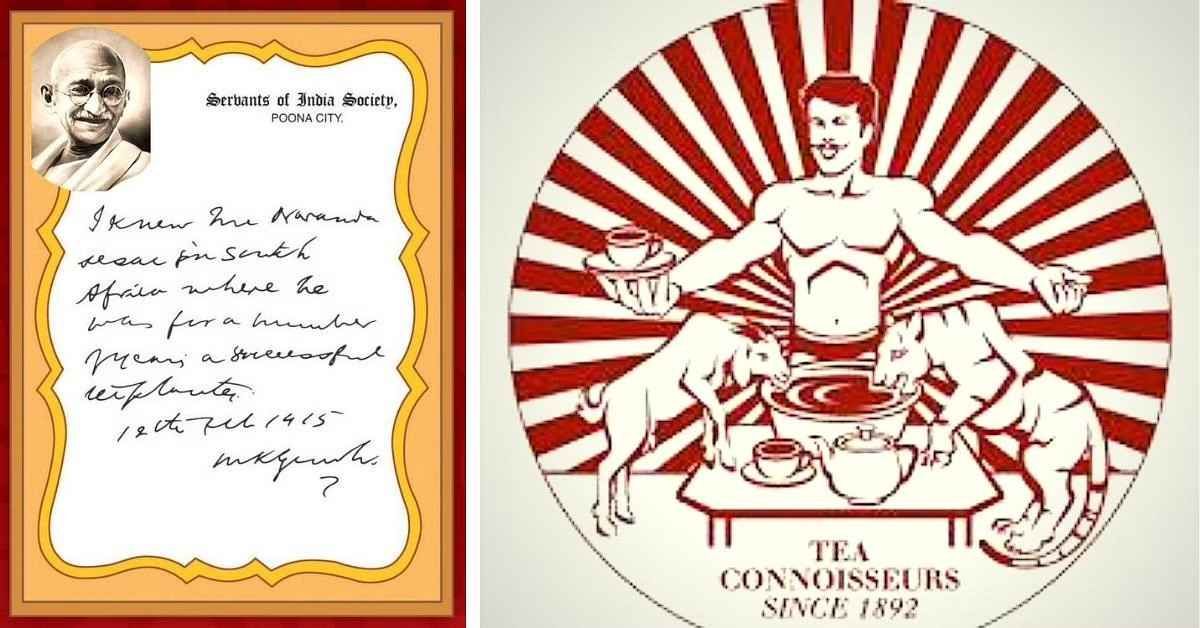They say behind every brand is a story of how it came to be, a story of what it set out to do and how it changed the market. And to reflect this tale is a significant, albeit small design, which is the brand logo.
But even while numerous brands flood the Indian markets today, there are a few whose logos stand out not only for the intrigue they create but also for the story that they brew behind the shiny design.
Here’s a look into some of the most iconic brands and their even more iconic logos.
1. Wagh Bakri Tea
In 1892 Narandas Desai set up his tea business with 500 acres of a tea estate in Durban, South Africa. However, due to racial discrimination and political unrest, he had to return to India in 1915 and start from scratch.
With Gandhi’s support, he established the Gujarat Tea Depot in Ahmedabad in 1919. At the time, the tea logo depicted an image of a wagh (tiger) drinking tea with a bakri (goat) in the same cup. The intent was to promote equality among all and counter racial discrimination.

In 1934 the Gujarat Tea Depot launched the Wagh Bakri Tea brand.
Today, the leading tea brand has a turnover of over Rs 1,500 crore and a distribution of over 40,000,000 kg.
2. Mysore Sandal Soap
Around the year 1918, Krishna Raja Wodiyar IV (the then Maharaja of Mysore) was gifted a rare set of sandalwood oil soaps which he loved. He wanted the state to start producing more of these and discussed the idea with Mokshagundam Visvesvaraya (the then Diwan of Mysore).
Visveswaraya wanted the perfect soap and in an attempt to have this invited technical experts from Mumbai for the research work which was to be conducted at the Indian Institute of Science (IISc).
One of the men, Sosale Garalapuri Shastry was so good that he was sent to England to fine-tune his knowledge about making soap. On his return to India, he came up with the Mysore Sandal Soap and also gave it a unique shape and innovative packaging.
Shastry wanted a design that stood apart from the rest and decided to base it on Indian jewels. So at the centre of a rectangular box that resembled a jewellery case, was a mythical creature Sharaba. It had the head of an elephant and the body of a lion and was a symbol of courage as well as wisdom. The scientist wanted it to symbolise the state’s rich heritage.
The soap went down in history for its design and appeal!
3. Doordarshan
Launched in New Delhi on 15 September 1959, the Doordarshan channel remains iconic to this day. But what catches viewers’ attention is the swirling logo with its spinning eye. Even more interesting is how the logo came to be.
When Devashish Bhattacharya a student at NID along with his friends was given the task of coming up with the logo, Bhattacharyya scribbled a human eye and drew two curves around it, depicting, “the yin and the yang”, and submitted his work to his teacher Vikas Satwalekar.
The simplicity of the design was loved by then PM Indira Gandhi and she immediately picked it for the television channel. For the animation, another student from NID RL Mistry made copies of Bhattacharyya’s sketches. He then shot them with a camera by rotating the images till they reached the final form. This gave rise to the popular ‘DD Eye’.
4. Nirma
In 1969, detergent giant Surf took the Indian market by storm with its formula and claims of being able to wash clothes until they were spotless. However, due to the price, many middle-class Indians steered clear of it.
This fuelled Karsanbhai Patel, a chemist at the Gujarat Government’s Department of Mining and Geology to come up with a solution that was affordable and could do the job of cleaning clothes well.
Thus, he developed a yellow-coloured detergent powder in his backyard and started selling it for Rs 3. He would go from door to door selling the product, and soon it picked up.
The brand was named Nirma, after Nirupama, Patel’s daughter, who had passed away in an accident. The logo too reflected this. Along with the logo of the girl in the frilly dress, and the catchy jingle that people hum till today, Nirma became a household name and the rest is history.
Patel was also featured in the Forbes list of India’s wealthiest (2009 and 2017).
5. Asian Paints
In 1942 following the ban by the British on importing paints, four friends in Mumbai decided to do something about it. Champaklal Choksey, Chimanlal Choksi, Suryakant Dani, and Arvind Vakil decided to come up with a solution to this in their garage. The results of their efforts resulted in the brand of today.
For their logo, the brand had a notorious kid with a paint bucket and brush in his hand. The sketch had been drawn by legendary illustrator RK Laxman. The brand then conducted a contest inviting people to name the figure that RK Laxman had created.
They received 47,000 entries.
Two people from Mumbai had named ‘Gattu’, a paint mascot equivalent to the Nirma girl. And that’s the story of the iconic logo.
Edited by Yoshita Rao
If you found our stories insightful, informative, or even just enjoyable, we invite you to consider making a voluntary payment to support the work we do at The Better India. Your contribution helps us continue producing quality content that educates, inspires, and drives positive change.
Choose one of the payment options below for your contribution-
By paying for the stories you value, you directly contribute to sustaining our efforts focused on making a difference in the world. Together, let's ensure that impactful stories continue to be told and shared, enriching lives and communities alike.
Thank you for your support. Here are some frequently asked questions you might find helpful to know why you are contributing?

